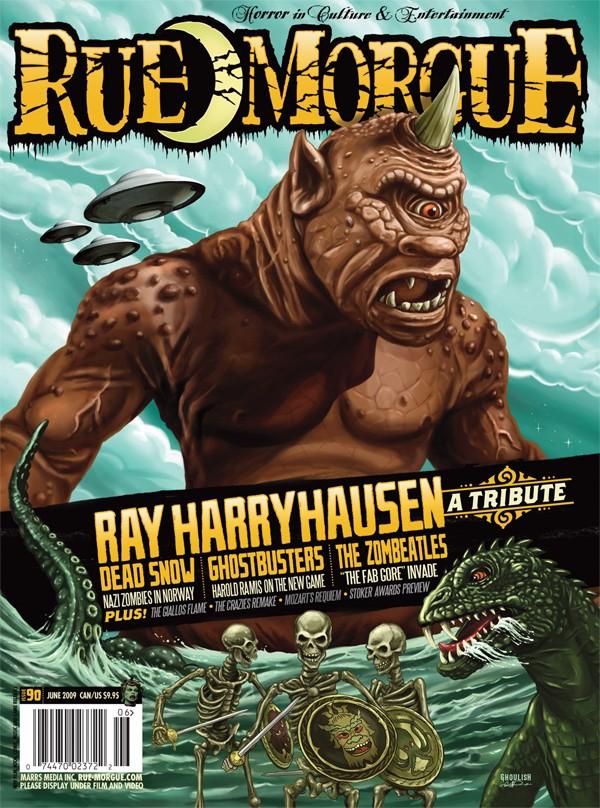 The new issue of Rue Morgue magazine, #90 (June 2009), recently hit newsstands. I knew when I received their weekly email announcement that I had to pick up a copy of this issue to add to my collection. The cover art drew my attention to the Ray Harryhausen tribute. Fans of fantasy films will be familiar with Harryhausen’s work and influence, have taken the stop-motion animation work of his mentor, Willis O’Brien working on the original King Kong, and transformed it into one of the most influential forms of special effects and entertainment starting in the 1950s and moving into the following decades. The tribute includes little that will be new to Harryhausen fans, but does serve as a good introduction and overview of his work, and also includes a new interview with the “majician” from his home in London.
The new issue of Rue Morgue magazine, #90 (June 2009), recently hit newsstands. I knew when I received their weekly email announcement that I had to pick up a copy of this issue to add to my collection. The cover art drew my attention to the Ray Harryhausen tribute. Fans of fantasy films will be familiar with Harryhausen’s work and influence, have taken the stop-motion animation work of his mentor, Willis O’Brien working on the original King Kong, and transformed it into one of the most influential forms of special effects and entertainment starting in the 1950s and moving into the following decades. The tribute includes little that will be new to Harryhausen fans, but does serve as a good introduction and overview of his work, and also includes a new interview with the “majician” from his home in London.
A few aspects of this tribute are worth noting. First, the coverage includes articles on two recent books on stop-motion that are essential for fans of the art form and Harrhausen’s work. These include Mike Hankin’s Ray Harryhausen: Master of the Majicks vol. 2, and Ray Harryhausen and Tony Dalton’s A Century of Stop-Motion Animation: From Melies to Aardman.
Second, the tribute includes curious references to Tim Burton’s The Nightmare Before Christmas. In an article on stop-motion by Jason Pichonsky, he concludes by mentioning the ongoing legacy of stop-motion through contemporary works such as The Pit and the Pendulum, and Coraline, and mention is also made of Burton’s The Corpse Bride, but curiously Pichonsky does not mention Nightmare, a film of grander scale and with considerably more complexity and ongoing cultural influence than Corpse. And in the interview with Harryhausen the legendary animator seems almost at pains to distinguish between Burton’s stop-motion works as “puppet films” in contrast with his own work that put “characters that were believable in a real context.” This is curious for two reasons. One, Harryhausen’s early work was in George Pal’s “Puppetoons” which then opened the door for his work with more realistic creatures as special effects. Two, it was due to Harryhausen’s influence on Burton that the director has helped keep the legacy of stop-motion going by producing some of the few studio films that feature the art form.
The final piece of Rue Morgue‘s tribute worth drawing attention to is a matter of accuracy in details. The normally very accurate folks at Rue Morgue missed a photo caption, mistakenly labeling Harryhausen’s pre-production artwork of the Ymir in 20 Million Miles to Earth and associating it with concept art for the Kracken in Clash of the Titans.
With this latest issue Rue Morgue continues to demonstrate that it is one of the top notch magazines addressing, as its subtitlte states, “horror in culture and entertainment.” This tribute to Harryhausen is less extensive and moving than their tribute to Forrest J. Ackerman just before his death, but their feature on this legendary animator and special effects technician demonstrates that they recognize his place in fantastic cinema history.





There are no responses yet